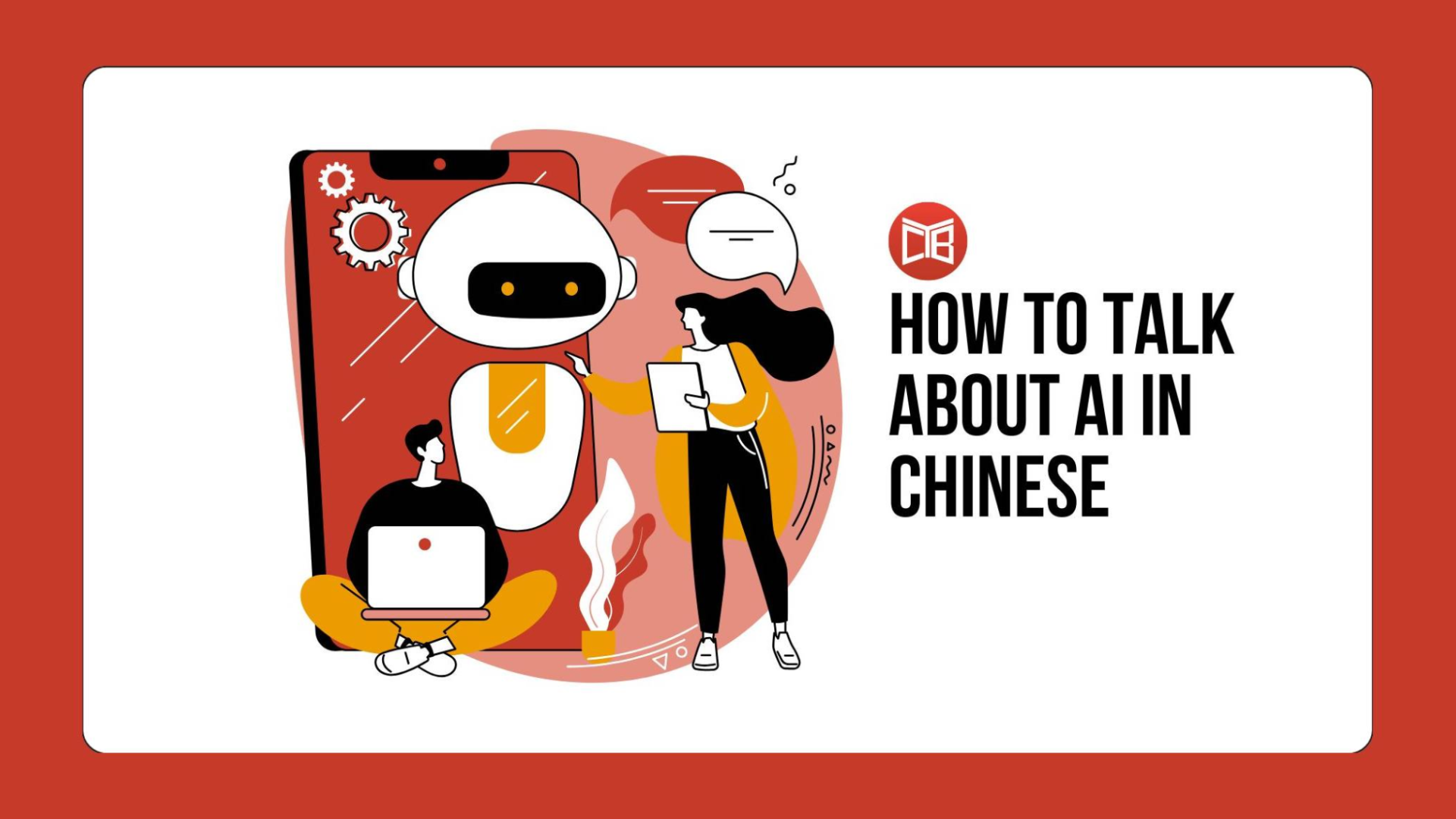
Artificial Intelligence (AI) has moved from the realm of science fiction into our daily lives, powering everything from recommendation engines to autonomous vehicles. Picture this: you’re at a tech meetup in Beijing, and someone mentions their latest AI side project. You nod along, but wouldn’t it feel great to jump in and say, “我也对人工智能很感兴趣!”?
In this article, we’ll break down how to say “AI” and “ChatGPT” in Chinese, introduce an extended vocabulary list covering popular tools like Sora and Perplexity, walk through sample dialogues to see terms in context, and answer frequently asked questions (FAQ) that learners often have.
Ready to dive into the world of AI in Chinese? 加油!
How to say “AI” in Chinese?
In Mandarin, “Artificial Intelligence” is simply 人工智能 (rén gōng zhì néng). The term is made up of two parts:
- 人工, which means “man-made, artificial”
- 智能, which means “intelligence, smarts”
Example:
人工智能正在改变我们的生活方式。
Rén gōng zhì néng zhèngzài gǎi biàn wǒmen de shēnghuó fāngshì.
“AI is transforming the way we live.”
This term is widely used in Chinese news articles, tech blogs, and casual conversation. You’ll see it on conference banners in China and hear it at every AI-focused meetup in Beijing.
How to say “ChatGPT” in Chinese?
Though “ChatGPT” remains an English brand name, Mandarin speakers often add the descriptive noun for clarity in formal settings:
ChatGPT 聊天机器人 (ChatGPT liáo tiān jī qì rén)
- 聊天 (liáo tiān) means “to chat”
- 机器人 (jī qì rén) means “robot / automated agent”
Example:
我每天早上都用 ChatGPT 聊天机器人帮我写邮件。
Wǒ měi tiān zǎoshang dōu yòng ChatGPT liáotiān jīqìrén bāng wǒ xiě yóujiàn.
“Every morning I have ChatGPT draft my emails.”
However, among friends and in casual chats, most people just say “用 ChatGPT” or “在 ChatGPT 上” without tacking on “聊天机器人”. Once it’s clear you’re talking about that specific tool, the extra words feel redundant.
For example, you might hear:
“我刚用 ChatGPT 写了封邮件。”
“I just used ChatGPT to write an email.”
“你在 ChatGPT 上试过那个新功能吗?”
“Have you tried that new feature on ChatGPT?”
“晚上用 ChatGPT 练英文挺好玩的。”
“It’s pretty fun practicing English with ChatGPT at night.”
If you’re in a tech talk or writing a blog post and want to be perfectly precise, you can say “ChatGPT 聊天机器人” once (for clarity), then just switch to “ChatGPT” for the rest of your talk or text. But in everyday speech, such as in WeChat groups, coffee-shop banter, Slack channels, “ChatGPT” alone is totally fine and widely understood.
Now you can brag about your AI assistant in Chinese, too!
Essential Vocabulary to Talk About AI in Chinese
Below is a categorized list of core and extended terms to help you navigate any AI discussion. Feel free to bookmark this section for quick reference! Think of it as your AI cheat sheet when you need to fire off a techie sentence in Mandarin:
Core AI-related Terms in Chinese
- AI (Artificial Intelligence) → 人工智能 (rén gōng zhì néng)
- ChatGPT → ChatGPT 聊天机器人 (ChatGPT liáo tiān jī qì rén)
- Machine Learning → 机器学习 (jī qì xué xí)
- Deep Learning → 深度学习 (shēn dù xué xí)
- Neural Network → 神经网络 (shén jīng wǎng luò)
- Big Data → 大数据 (dà shù jù)
- Algorithm → 算法 (suàn fǎ)
- Automation → 自动化 (zì dòng huà)
Generative AI & LLM Concepts in Chinese
- Generative AI → 生成式人工智能 (shēng chéng shì rén gōng zhì néng)
- Large Language Model (LLM) → 大型语言模型 (dà xíng yǔ yán mó xíng)
- Prompt (ChatGPT prompt) → 提示词 (tí shì cí)
- AI Agent → AI 智能体 / AI 代理 (AI zhì néng tǐ / AI dài lǐ)
Popular AI Tools & Platforms in Chinese
- Perplexity (answer engine) → Perplexity AI / Perplexity 搜索 (Perplexity sōu suǒ)
- Sora (OpenAI video generator) → Sora 视频生成 (Sora shì pín shēng chéng)
- Google Gemini → Google Gemini / Gemini 人工智能助手 (Gemini rén gōng zhì néng zhù shǒu)
- DeepSeek (Chinese LLM) → DeepSeek / 深度求索大模型 (shēn dù qiú suǒ dà mó xíng)
Application & Feature Terms in Chinese
- Voice Assistant → 语音助手 (yǔ yīn zhù shǒu)
- Voice Cloning → 声音克隆 (shēng yīn kè lóng)
- AI Art / Image Creators → AI 艺术 / AI 作画 (AI yì shù / AI zuò huà)
- Smart Home → 智能家居 (zhì néng jiā jū)
- Self-Driving (Autonomous Driving) → 自动驾驶 (zì dòng jià shǐ)
- Facial Recognition → 人脸识别 (rén liǎn shí bié)
- AI Features (built-in tools) → AI 功能 (AI gōng néng)
- AI Overview (Google Search feature) → AI 概览 (AI gài lǎn)
Roles, Benefits & Concerns in Chinese
- AI Expert → AI 专家 (AI zhuān jiā)
- Benefits of AI → AI 的好处 (AI de hǎo chù)
- Challenges of AI → AI 的挑战 (AI de tiǎo zhàn)
- Will AI Replace Humans? → AI 会取代人类吗?(AI huì qǔ dài rén lèi ma?)
- AI Needs Ethical Guidelines → AI 需要伦理规范 (AI xū yào lún lǐ guī fàn)
- AI-Powered (marketing label) → AI 加持 / AI 驱动 (AI jiā chí / AI qū dòng)
Essential AI Vocabulary in Chinese (Table)
| English Term | Mandarin | Pinyin |
| AI (Artificial Intelligence) | 人工智能 | rén gōng zhì néng |
| ChatGPT | ChatGPT 聊天机器人 | ChatGPT liáo tiān jī qì rén |
| Machine Learning | 机器学习 | jī qì xué xí |
| Deep Learning | 深度学习 | shēn dù xué xí |
| Neural Network | 神经网络 | shén jīng wǎng luò |
| Big Data | 大数据 | dà shù jù |
| Algorithm | 算法 | suàn fǎ |
| Automation | 自动化 | zì dòng huà |
| Generative AI | 生成式人工智能 | shēng chéng shì rén gōng zhì néng |
| Large Language Model (LLM) | 大型语言模型 | dà xíng yǔ yán mó xíng |
| Prompt (ChatGPT prompt) | 提示词 | tí shì cí |
| AI Agent | AI 智能体 / AI 代理 | AI zhì néng tǐ / AI dài lǐ |
| Perplexity (answer engine) | Perplexity AI / Perplexity 搜索 | Perplexity AI / Perplexity sōu suǒ |
| Sora (OpenAI video generator) | Sora 视频生成 | Sora shì pín shēng chéng |
| Google Gemini | Google Gemini / Gemini 人工智能助手 | Google Gemini / Gemini rén gōng zhì néng zhù shǒu |
| DeepSeek (Chinese LLM) | DeepSeek / 深度求索大模型 | DeepSeek / shēn dù qiú suǒ dà mó xíng |
| Voice Assistant | 语音助手 | yǔ yīn zhù shǒu |
| Voice Cloning | 声音克隆 | shēng yīn kè lóng |
| AI Art / Image Creators | AI 艺术 / AI 作画 | AI yì shù / AI zuò huà |
| Smart Home | 智能家居 | zhì néng jiā jū |
| Self-Driving (Autonomous Driving) | 自动驾驶 | zì dòng jià shǐ |
| Facial Recognition | 人脸识别 | rén liǎn shí bié |
| AI Features (built-in tools) | AI 功能 | AI gōng néng |
| AI Overview (Google Search feature) | AI 概览 | AI gài lǎn |
| AI Expert | AI 专家 | AI zhuān jiā |
| Benefits of AI | AI 的好处 | AI de hǎo chù |
| Challenges of AI | AI 的挑战 | AI de tiǎo zhàn |
| Will AI Replace Humans? | AI 会取代人类吗? | AI huì qǔ dài rén lèi ma? |
| AI Needs Ethical Guidelines | AI 需要伦理规范 | AI xū yào lún lǐ guī fàn |
| AI-Powered (marketing label) | AI 加持 / AI 驱动 | AI jiā chí / AI qū dòng |
Sample Dialogues
Below are a few short scenarios to illustrate how these terms flow naturally.
Dialogue 1: Casual Tech Chat
Alice: 你听说过 Sora 吗?
(Nǐ tīng shuō guò Sora ma?)
“Have you heard of Sora?”
Bob: 听说了。它是 OpenAI 的视频生成工具,对吗?
(Tīng shuō le. Tā shì OpenAI de shìpín shēngchéng gōngjù, duì ma?)
“Yes, I heard it’s OpenAI’s video generator, right?”
Alice: 对。而且它还能根据提示词生成短视频。
(Duì. Érqiě tā hái néng gēnjù tíshìcí shēngchéng duǎn shìpín.)
“Right. And it can generate short videos from prompts.”
Bob: 太酷了!我想试试生成式人工智能的功能。
(Tài kù le! Wǒ xiǎng shìshi shēngchéng shì réngōng zhìnéng de gōngnéng.)
“Awesome! I want to try the generative AI features.”
Dialogue 2: Workplace Discussion
Manager: 我们下周的项目报告,可以用 ChatGPT 聊天机器人来起草吗?
(Wǒmen xià zhōu de xiàngmù bàogào, kěyǐ yòng ChatGPT liáotiān jīqìrén lái qǐcǎo ma?)
“For next week’s project report, can we use the ChatGPT chatbot to draft it?”
Colleague: 可以,记得给它一些详细的提示词。
(Kěyǐ, jìde gěi tā yīxiē xiángxì de tíshìcí.)
“Sure, just remember to give it detailed prompts.”
Manager: 好。还有,把自动化流程的部分用图表展示。
(Hǎo. Hái yǒu, bǎ zìdònghuà liúchéng de bùfen yòng túbiǎo zhǎnshì.)
“Okay. Also, illustrate the automation workflow with charts.”
Colleague: 明白。我会用大数据分析来支持演示。
(Míngbái. Wǒ huì yòng dà shùjù fēnxī lái zhīchí yǎnshì.)
“Got it. I’ll use big data analysis to back up the presentation.”
Dialogue 3: Ethics & “Will AI Replace Us?”
Reporter: 最近大家都在问:AI 会取代人类吗?
(Zuìjìn dàjiā dōu zài wèn: AI huì qǔ dài rén lèi ma?)
“Lately everyone’s asking: Will AI replace humans?”
Expert: 在某些重复性、可自动化的工作岗位上,AI 确实可能取代人类;但同时它也会创造新的职业机会。
(Zài mǒuxiē chóngfù xìng, kě zìdònghuà de gōngzuò gǎngwèi shàng, AI quèshí kěnéng qǔ dài rén lèi; dàn tóngshí tā yě huì chuàngzào xīn de zhíyè jīhuì.)
“In certain repetitive, automatable roles, AI can indeed replace humans; but at the same time it will also create new job opportunities.”
Reporter: 那我们该如何应对这些 AI 的挑战?
(Nà wǒmen gāi rúhé yìngduì zhèxiē AI de tiǎozhàn?)
“Then how should we address these challenges of AI?”
Expert: 最重要的是制定和落实 AI 需要伦理规范,确保技术发展既有创新动力,又兼顾社会责任。
(Zuì zhòngyào de shì zhìdìng hé luòshí AI xūyào lúnlǐ guīfàn, quèbǎo jìshù fāzhǎn jì yǒu chuàngxīn dònglì, yòu jiāngù shèhuì zérèn.)
“The key is to establish and enforce that AI needs ethical guidelines, ensuring technological progress has both innovative drive and social responsibility.”
Dialogue 4: AI Art
小张: 最近我在试一个生成式人工智能的AI作画平台,只要输入提示词,就能自动生成插画。
(Zuìjìn wǒ zài shì yī ge shēngchéng shì réngōng zhìnéng de AI zuòhuà píngtái, zhǐyào shūrù tíshìcí, jiù néng zìdòng shēngchéng chāhuà.)
“I’ve been playing with a generative AI art platform, just type in a prompt and it automatically creates illustrations.”
小刘: 真的吗?哪家的?我也想试试AI艺术。
(Zhēn de ma? Nǎ jiā de? Wǒ yě xiǎng shìshi AI yìshù.)
“Really? Which one? I want to try AI art too.”
小张: 一个国外开的,界面很简单。我让它用“北京胡同黄昏”当提示词,结果出来一幅超有氛围的水彩风景。
(Yī ge guówài kāi de, jièmiàn hěn jiǎndān. Wǒ ràng tā yòng “Běijīng hútòng huánghūn” dāng tíshìcí, jiéguǒ chūlái yī fú chāo yǒu fēnwéi de shuǐcǎi fēngjǐng.)
“It’s a foreign service with a super simple interface. I used ‘Beijing alley at dusk’ as a prompt, and it spat out a moody watercolor scene.”
小刘: 真的吗?听起来很酷!
(Zhēn de ma? Tīng qǐlái hěn kù!)
“Really? Sounds awesome!.”
FAQ
Q1: When should you use “AI 功能” vs. “智能功能”?
AI 功能 (AI gōng néng) usually refers to a specific, built-in artificial intelligence module in an app or device, for example, the “Night-mode AI feature” on a camera. 智能功能 (zhì néng gōng néng) is broader, meaning any feature that uses “smart” technology, such as smart recommendations or smart search.
Q2: What’s the difference between “Generative AI” and “Deep Learning”?
Generative AI (生成式人工智能) emphasizes AI’s ability to create new content (text, images, video, etc.) based on your prompts. Meanwhile, Deep Learning (深度学习) is one family of AI techniques that uses multi-layer neural networks to “learn” patterns from data.
Q3: How do you pronounce “提示词” correctly?
This is a tricky one for non-natives! 提示 is second tone + fourth tone: tí shì, while 词 is second tone: cí. Put together, it is tí-shì cí.
I’ll break down “提示词” into its three syllables to make it more manageable:
- 提 (tí) sounds like English “tea” but start mid-pitch and rise (as if asking a question: “tea?”). Imagine your voice sliding upward at the end.
- 示 (shì) sounds similar to English “shirt” without the “rt” (so more like “sh-ih”). The tone falls sharply from high to low (like giving a command: “Sit!”).
- 词 (cí) sounds like “ts” + “uh” (like the start of “tsunami”), with that same rising tone.
Q4: Are there any slang or internet terms?
- 人工智障 (réngōng zhìzhàng) is a playful jab when AI fails or acts “stupid.”
- AI 大神 (AI dàshén) is someone who’s a true “wizard” or top expert in the AI field.
Q5: How can you practice these terms?
- Keep a journal and write one sentence each day using 3–5 new AI-related words.
- Chat with a native Chinese speaker about tech topics.
- Read AI articles on blogs and news.
Next time you’re asking a question at an AI meetup or presenting an automation workflow in a meeting, don’t hesitate to use these terms confidently. Before you know it, you’ll be the one people turn to for Mandarin tech talk. Keep practicing, rehearse dialogues with friends, and post on social media to reinforce your skills. 加油!
If you come across more cool AI terms or have any questions, feel free to share them in the comments below!
Author Bio:

Wey Chynn is a native Chinese speaker from Malaysia with a deep-rooted passion for language and culture. With five years of experience as a Chinese-to-English translator, she specializes in delivering accurate and natural translations that preserve the essence of the original text. Growing up in a multilingual environment, she developed a keen understanding of linguistic nuances, enabling seamless and culturally sensitive translations.























